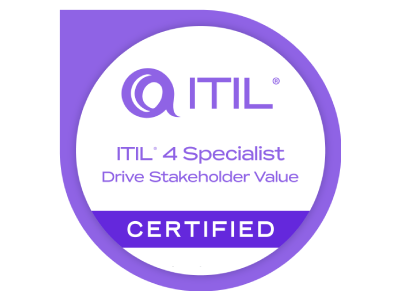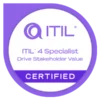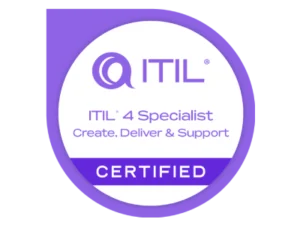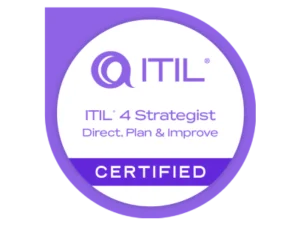ITIL® 4 Specialist: Drive Stakeholder Value
This ITIL® 4 Specialist: Drive Stakeholder Value course covers important CX, UX, and journey mapping principles as well as the engagement and interactions between service providers and clients, users, suppliers, and partners. Learn how to build an IT company that is “learning and improving.”
Overview
A thorough program created to help students navigate the complexities of maintaining and cultivating relationships with stakeholders is the ITIL® 4 Specialist Drive Stakeholder Value course. From the first investigation of client demands to the ultimate realization of service value, it places a strong emphasis on mastering the customer experience. Each of the eight modules in the course—Explore, Engage, Offer, Agree, Onboard, Co-create, and Realize—covers a different stage of the customer journey. Learners will acquire knowledge about managing service touchpoints and interactions as well as creating, assessing, and enhancing customer journeys. They will learn how to negotiate and agree on services, customize services to meet customer needs, and make sure these services benefit both the provider and the customer.
What you will Learn in this ITIL® 4 Specialist Drive Stakeholder Value Course?
- Understand the importance of the customer journey in creating and maximizing stakeholder value within service management.
- Identify and analyze touchpoints and service interactions to enhance the customer experience.
Learn how to map and design customer journeys that align with organizational objectives and customer needs. - Develop strategies for effective exploration of service consumer needs and service provider capabilities.
- Acquire skills to engage with customers and stakeholders, building and sustaining trust and strong service relationships.
- Gain knowledge in shaping demand, specifying customer requirements, and designing service offerings for optimal user experience.
- Master the art of negotiating and agreeing on services that facilitate value co-creation with customers.
- Learn how to effectively onboard customers, fostering relationships and enabling users for service through ITIL management practices.
- Understand the co-creation of value in service provision and the nurturing of user communities for ongoing service interactions.
- Measure and realize service value, capturing and improving customer journey experiences, and evaluating value realization for both customers and service providers.
Who should take up this ITIL® 4 Specialist Drive Stakeholder Value Course?
- IT Service Managers
- Customer Experience (CX) Managers
- Relationship Managers
- Account Managers
- Service Delivery Managers
- Service Level Managers
- Enterprise Architects
- Business Analysts
- Project Managers
- Marketing Managers
- IT Consultants
- IT Support Staff
- Product Owners
- Customer Success Managers
- Sales Professionals within IT organizations
Our Package
1.01 Course Introduction
2.01 The Customer Journey
2.02 The Customer Journey Definition
2.03 The Customer Journey Example
2.04 Customer Journeys and Value Streams
2.05 Mastering the Customer Journey
2.06 Stakeholder Aspirations
2.07 Touchpoints and Service Interactions
2.08 Mapping the Customer Journey
2.09 Personas
2.10 The Customer Experience
2.11 Design the Customer Journey
2.12 Design Thinking
2.13 Leveraging Behavioral Psychology
2.14 Design for Different Cultures
2.15 Measure and Improve the Customer Journey
2.16 Key Takeaways
Knowledge Check
3.01 Targeting Markets and Stakeholders
3.02 Importance of Service Needs
3.03 Service Consumers and Their Needs
3.04 External Factors
3.05 Internal Factors
3.06 SWOT Analysis
3.07 Service Objectives and Opportunities
3.08 Risk Assessment
3.09 Service Providers and Their Offerings
3.10 Markets
3.11 Characteristic-Based Market Segmentation
3.12 Need-Based Market Segmentation
3.13 Identify and Analyze Service Consumers
3.14 Targeting Markets
3.15 Targeted Marketing
3.16 Key Takeaways
Knowledge Check
4.01 Fostering Stakeholder Relationships
4.02 Stakeholder Relationships
4.03 Communication and Collaboration
4.04 Listening Modes
4.05 Service Relationship Types
4.06 Basic Relationship
4.07 Cooperative Relationship
4.08 Partnership
4.09 Build Service Relationships
4.10 Service Relationship Ladder Step One
4.11 Service Catalog
4.12 Customer Relationship Management
4.13 Service Relationship Ladder Step Two
4.14 The Three Cs of Trustworthiness
4.15 Service Relationship Ladder Step Three
4.16 Service Relationship Ladder Step Four
4.17 Experience and Preferences
4.18 Service Relationship Ladder Step Five
4.19 Assessing Mutual Readiness and Maturity
4.20 Assessing Readiness for Collaboration
4.21 The Service Relationship Management Practice
4.22 Managing Suppliers and Partners
4.23 Service Integrator Activities
4.23 The Supplier Management Practice
4.25 The Supplier Management Practice Success Factors
4.26 Key Takeaways
Knowledge Check
5.01 Shape Demand and Define Service Offerings
5.02 Managing Demand and Opportunities
5.03 Optimizing Capacity
5.04 Shaping or Smoothing Demand
5.05 Service Improvement Opportunities
5.06 Building the Customer Business Case
5.07 Areas of Conflict and Uncertainty
5.08 Conflicting Priorities and Needs
5.09 Building Service Provider Business Case
5.10 Business Analysis
5.11 Roles and Responsibilities Examples
5.12 Managing Requirements
5.13 Separating the Problem from the Solution
5.14 Minimum Viable Product
5.15 User Stories and Story Mapping
5.16 Articulate Requirements
5.17 The MoSCow Method
5.18 Weighted Shortest Job First
5.19 Service Offerings and User Experience
5.20 Lean Thinking
5.21 Aspects of Agile
5.22 Aspects of Agile Continuous Delivery
5.23 Service Blueprint
5.24 Designing for Onboarding
5.25 Selling and Obtaining Service Offerings
5.26 Pricing Options
5.27 Internal and External Sales
5.28 Business Analysis Practice
5.29 Key Takeaways
Knowledge Check
6.01 Align Expectations and Agree Services
6.02 Aligning Expectations
6.03 Value Co-Creation
6.04 Service Interaction Method
6.05 Example of Service Interaction Method
6.06 Inherent and Assigned Characteristics of Services
6.07 Service Consumer Needs and Agreements
6.08 Negotiate and Agree to Services
6.09 Warranty
6.10 Experience
6.11 Negotiate and Agree on Terms and Conditions
6.12 The Service Level Management Practice
6.13 Shared View of Target Service Levels with Customers
6.14 Service Quality Aspects
6.15 The Organization with the Defined Service Levels
6.16 Service Reviews and Improvement Opportunities
6.17 Key Takeaways
Knowledge Check
7.01 Onboard and Offboard Customers and Users
7.02 Onboarding Service Customers
7.03 Planning Onboarding
7.04 Relating with Users and Fostering Relationships
7.05 Fostering Relationships with Corporate Users
7.06 Fostering Relationships with Individual Consumers Part One
7.07 Fostering Relationships with Individual Consumers Part Two
7.08 User Engagement and Delivery Channels
7.09 Choice and Design Affecting Trends
7.10 Omnichannel Communication Challenges Part One
7.11 Omnichannel Communication Challenges Part Two
7.12 Enable Users for Service
7.13 Service Catalog and Service Desk
7.14 Elevate User Capabilities
7.15 Elevate Service Provider Capabilities
7.16 Onboarding Goals
7.17 Onboarding Scope
7.18 Onboarding Initiatives Start and End
7.19 Onboarding Customers and Users Onboarding Actions
7.20 User Onboarding
7.21 Onboarding Control
7.22 Reviewing Onboarding Control
7.23 Offboarding Customers and Users
7.24Customer Offboarding
7.25 User Offboarding
7.26 Service Transition Onboarding and Offboarding
7.27 Service Catalog Management Practice
7.28 Service Desk Practice
7.29 User Satisfaction
7.30 Service Desk Practice Success Factors
7.31 Communication Channels Challenges and Solutions
7.32 Effective Integration of Communication Channels
7.33 Key Takeaways
Knowledge Check
8.01 Continual Value Co-Creation
8.02 Value Co-Creation
8.03 Service Mindset for Service Provision and Consumption – Part One
8.04 Service Mindset for Service Provision and Consumption – Part Two
8.05 Services with Invisible Users
8.06 Ongoing Service Interactions
8.07 Service Interactions Based on Architecture
8.08 Service Requests
8.09 Service Desk Interactions
8.10 Moments of Truth
8.11 Intelligent Disobedience
8.12 Customer and User Feedback
8.13 Nurturing User Communities
8.14 Super users
8.15 Service Request Management Practice
8.16 Service Request Management Practice – Success Factors
8.17 Key Takeaways
Knowledge Check
9.01 Service Value Realization
9.02 Value Realization
9.03 Realizing Service Value in Different Settings Part One
9.04 Realizing Service Value in Different Settings Part Two
9.05 Tracking Value Realization
9.06 Tracking Performance Output and Outcome
9.07 Value Driver Framework Model
9.08 Service Profit Chain
9.09 Tracking Experience and Satisfaction
9.10 Ways to Monitor Customer Experience
9.11 Tracking Service Usage
9.12 Assessing and Reporting Value Realization
9.13 Two Levels of Assessing and Reporting Value Realization
9.14 Evaluating Value Realization and Improving Customer Journeys
9.15 Sources of Continual Improvement
9.16 Tracking Assessing and Evaluating Outcomes
9.17 Charging
9.18 Billing
9.19 Portfolio Management Practice
9.20 Portfolio Management Practice – Success Factors
9.21 Key Takeaways
Knowledge Check
Upcoming Batch
April 20th (Weekends)
FRI & SAT (4 Weeks)
08:30 PM to 01:00 AM (CDT)
April 18th (Weekdays)
MON – FRI (18 Days)
10:00 AM to 12:00 PM (CDT)
ITIL® 4 Specialist: Drive Stakeholder Value FAQs
The ITIL® 4 Specialist: Drive Stakeholder Value course covers customer journey mapping, SLA design, relationship management, and value stream optimization to enhance stakeholder satisfaction in IT service management.
After ITIL® 4 Specialist training, prospects include roles like IT Service Manager, Customer Experience Lead, Relationship Manager in various industries, with potential for advancement to senior ITSM positions and higher salaries.
- Hold the ITIL® 4 Foundation certificate or a higher-level ITIL® 4 certification.
- Have a basic understanding of Service Management concepts and principles.
- Familiarity with IT terminology and IT-related work experience would be beneficial.
- An interest in improving stakeholder relationships and driving customer value within the context of IT services.
The duration of the course 24 hours.
A laptop, decent internet speed, a Headset with microphone is required.








Reviews
There are no reviews yet.